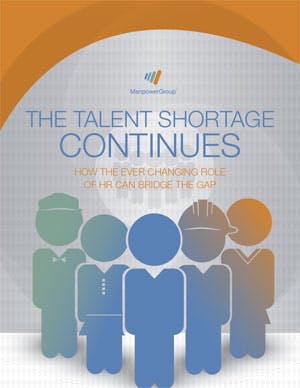ManpowerGroup’s 10th annual Talent Shortage Survey is out, and it reveals that 32 percent of U.S. employers report difficulties filling job vacancies due to talent shortages.
This marks a decrease of 8 percent, down from 40 percent in 2014. Globally, the percentage of employers experiencing difficulties continued to rise, increasing from 36 percent in 2014 to 38 percent this year.
Why does it matter?
Among U.S. employers, 48 percent acknowledge that talent shortages have a medium to high impact on their business, but few are putting talent strategies in place to address the problem.
One in five U.S. employers is still not pursuing strategies to overcome talent shortages, despite the negative impact on their business. This is up from 12 months ago when 13 percent of U.S. employers reported they were not pursuing strategies to overcome talent shortages.
“Talent shortages are real and are not going away,” said Kip Wright, senior vice president,Manpower North America. “Despite impacts to competitiveness and productivity, our research shows fewer employers are trying to solve the problem through better talent strategies. As the struggle to find the right talent continues, and candidates with in-demand skills get the upper hand, employers will be under pressure to position themselves as ‘talent destinations’ to attract the best workers that will drive their business forward.”
What are hardest jobs to fill?
For the sixth consecutive year, skilled trade vacancies are the hardest to fill in the U.S., and for the fourth consecutive year, skilled trade roles are the hardest to fill globally. Also on the list of hardest to fill jobs in the U.S. are drivers and teachers.
The U.S. jobs most in demand in 2015 are:
- Skilled trade workers;
- Drivers;
- Teachers;
- Sales representatives;
- Administrative professionals;
- Management/executives;
- Nurses;
- Technicians;
- Accounting and finance staff;
- Engineers.
Compare this to the most in demand U.S. jobs last year:
- Skilled trade workers;
- Restaurant and hotel staff;
- Sales representatives;
- Teachers;
- Drivers;
- Accounting and finance staff;
- Laborers;
- IT staff;
- Engineers;
- Nurses.
What’s the impact?
Some 43 percent of U.S. employers say talent shortages are having a negative impact on their ability to meet client needs. The consequences include:
- Reduced competitiveness and productivity (41 percent);
- Increased employee turnover (32 percent);
- Higher compensation costs (32 percent);
- Reduced employee engagement/morale (32 percent).
When asked why they are struggling to fill certain jobs, employers cite a lack of applicants (33 percent), lack of experience (19 percent), and lack of technical competencies or hard skills (17 percent). Technical competencies employers seek include industry-specific professional qualifications (7 percent) and trade certifications (7 percent).
For more on the U.S. talent shortage, including the complete report and infographic, visit ManpowerGroup’s U.S. Talent Shortage microsite.
This was originally published on Manpower Group’s Employment Blawg.
